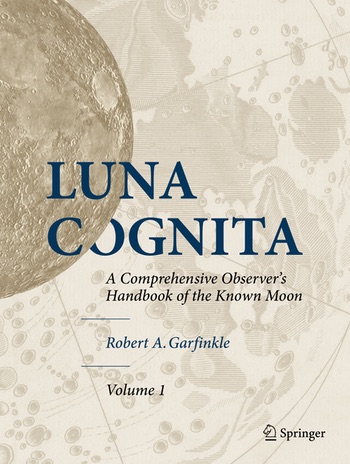Review: Luna Cognitaby Joseph T. Page II
|
| Over the past few centuries, especially since the human exploration missions, the Moon has had a lot written about it. One might wonder, “Is another book about the Moon really needed?” |
Volume 1 provides foundational knowledge about the lunar history and lore before delving into the theories behind its formation and settling into orbit near Earth. For lunar neophytes, Volume 1 includes selenographic information—vocabulary, descriptions, and generalized questions—that could easily overwhelm a nascent investigator working without a guide. For astrophotography, Garfinkle provides descriptions of lunar observing equipment (Chapter 4) and settings and “best practices” (Chapter 5 and 6) before leading into crater observation during specific days of the lunar cycle (Chapters 7 through 21). These topics would be a worthwhile volume in itself; however, Garfinkle has more to deliver through Volume 2 and 3 of his series.
The second volume covers observation and measuring techniques for those wanting to move beyond the “gee-whiz” coverage of lunar features. A great section in Volume 2 discusses how to draw observations of the Moon, an invaluable skill that can boost observational worth for both amateur and professional astronomers alike. Volume 2 closes out with significant information on eclipses, both lunar and solar. The final volume contains appendices to the series. Instead of just tables of places and origins of names (which are present, and wholly comprehensive), mathematical equations give logic-minded observers a way to generate their own computational figures as well as ephemeris information through 2035.
Any drawbacks to the Luna Cognita series are purely administrative, based upon the physical presentation of the voluminous amount of data. For example, the book splits the sections on “Crater Hopping” through each day of the Moon’s cycle between the end of Volume 1 and the start of Volume 2. With each volume weighing nearly two kilograms, this split forces the reader to select which book they want to lug around during their Moon watch period. A handful of photographs present as full-page images, but at a resolution less than 300 dots per inch, revealing heavily pixelation obscuring lunar features identified in the caption. The majority of images, however, are of sufficient resolution for holistic viewing as well as crater-bump investigation. The final gripe involves purchasers receiving one book of the three-volume set: many of the Amazon “one-star” reviews are based upon this and not the book’s internal content.
Garfinkle’s Luna Cognita series will overwhelm you the moment it arrives in the mail, but no more than Luna overwhelmed our prehistoric ancestors looking up at the nighttime skies. Serious selenographers will want to own a copy of this three-volume series for their collection.
Note: we are temporarily moderating all comments submitted to deal with a surge in spam.
